| Toyo Ink SC Holdings, Co., Ltd. (4634) |
|
||||||||
Company |
Toyo Ink SC Holdings, Co., Ltd. |
||
Code No. |
4634 |
||
Exchange |
TSE 1st Section |
||
Industry |
Chemical (Manufacturing) |
||
President and CEO |
Katsumi Kitagawa |
||
Address |
3-7-1 Kyobashi, Chuo-ku, Tokyo |
||
Year-end |
End of March |
||
HP |
|||
* Share price as of closing on the end of November 21. Number of shares outstanding is as of quarter end from the most recent earnings briefing. ROE and BPS are based on actual results of the previous term end.
|
||||||||||||||||||||||||
|
|
* Estimates are those of the Company. Net income is net income attributable to owners of parent.
|
| Key Points |
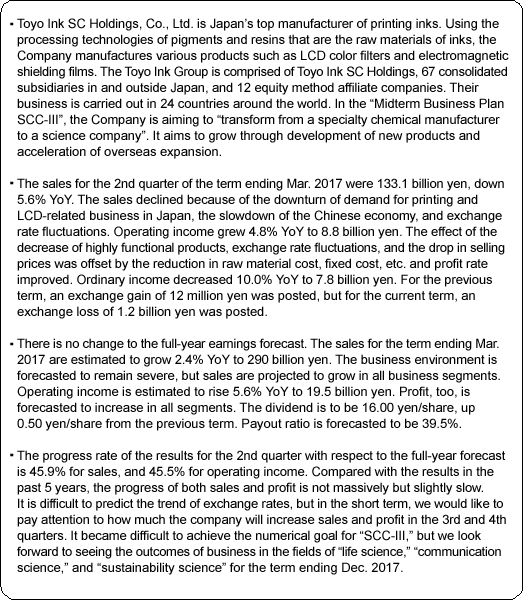 |
| Company Profile |
|
Initially, inks in the Japanese market were mostly imported products; however, as the national policy favored high quality domestically produced inks, the Company, with its advanced technological skills, successfully expanded its business with clients such as the Printing Bureau of the Ministry of Finance and other government bodies, in addition to private printing companies. Exports also grew during the same time. The Company's rapid growth was also due in part to the early introduction of integrated manufacturing system from raw materials (pigments, resins) to finished products (printing inks). Another contributing factor may be that the Company, since its inception, had strong ties with Toppan Printing Co., Ltd., which, by then, was among Japan's largest printing companies. The Company survived the difficult times of the Great Kanto Earthquake and the World War II and experienced rapid growth again during the period of high economic growth after the war. The Company was listed in the Second Section of the Tokyo Stock Exchange in 1961 and moved to the First Section of the Tokyo Stock Exchange in 1967. The Company is expanding its businesses from manufacturing of printing inks to other fields such as LCD film materials, using its wide range of technologies and know-how cultivated through manufacturing and processing of raw materials such as pigments and resins. In 2011, the Company adopted a holding company system for further expansion and growth of the Group, and changed its name to Toyo Ink SC Holdings, Co., Ltd. In April 2014, "improving shareholder satisfaction" was added to its guiding principles. With this revision, the Company is aiming to improve satisfaction of all stakeholders. 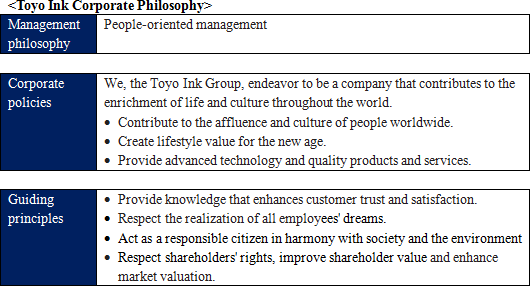 Furthermore, the "Toyo Ink Group Corporate Philosophy" is printed on the first page of every single issue of the Company's in-house magazine, which is published for the Group's unity and circulated to the entire Group including the overseas locations. Also, the above-mentioned credo has "Japanese/English" version as well as "Chinese/English" version to share and spread the corporate philosophy globally. ◎ Overview (Market trend) In the realm of commercial printing, on the other hand, of posters, catalogues, fliers, POP, etc. demand is fairly steady. Furthermore, printing on food and pharmaceutical packages and plastic containers is steadily increasing at the compound annual growth rate (CAGR) of 2.4% from 2004 to 2015. 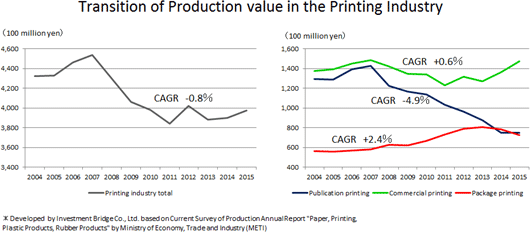 As innovation of printing machine is progressing, quality of printing is enhancing. Overseas local inks, in many cases, cannot respond to such demand for high quality, which may lead to more demand of excellent Japanese ink. (Printing houses and printing ink manufacturers)
According to the "Census of Manufactures 2014: Report by Industry" by METI, there were 25,843 business entities in the printing and related industries in 2014. 25,446 (98.5%) of them are small and medium-sized enterprises with fewer than 100 employees.
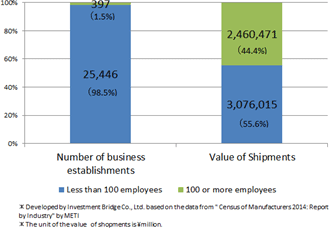 with information on new products and various advices concerning these needs and challenges. Most of the 26,000 printing companies in Japan can hardly conduct business without such solutions. Therefore, printing ink manufacturers play a crucial role in the printing industry. Thus, the Company's customers seek direct dealings with the Company. As a result, nearly 80% of the Company's domestic sales come from direct sales to its customers. These strong relationships with the customers are among the Company's major characteristics. ◎ Other companies in the industry
There are 6 major listed companies including Toyo Ink in the ink industry in Japan. Whereas (4631) DIC is the number one company in the world, Toyo Ink is the top runner in Japanese printing ink industry, and ranks first or second by most product categories. Globally, the Company is ranked third (The second is a European firm). (4633) SAKATA INX is the second largest shareholder of the Company. The Company and SAKATA INX complement each other mainly in logistical aspects. The two companies concluded a capital and business alliance agreement in 2000. 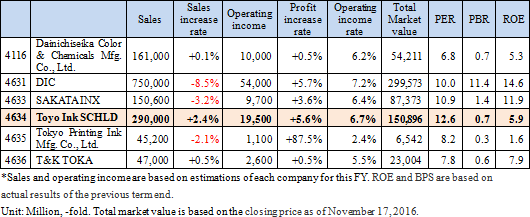 ◎ Concerning "printing inks"  Since its foundation, the Company also has been expanding its business categories by exploring application of these raw materials in the process of manufacturing them.  ◎ Business segments
The business activities of the Company are classified into 4 segments: the "Colorants & Functional Materials Related Business", "Polymers & Coatings Related Business", "Printing & Information Related Business", and "Packaging Materials Related Business".The "Printing & Information Related Business" mainly deals with planographic inks that are used for printing on papers (offset inks, etc.). The "Packaging Materials Related Business" deals with gravure inks and flexographic inks that are used for printing on films of food packages. The "Colorants & Functional Materials Related Business" deals with products related to pigments that are also the raw materials of printing inks as core materials. The "Polymers & Coatings Related Business" began with resins that are the main raw materials of inks and their design technologies. 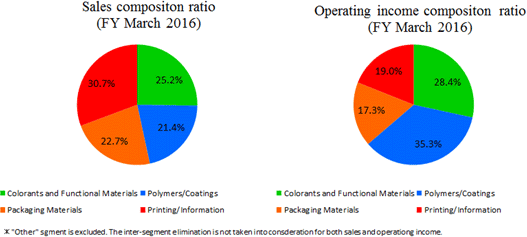 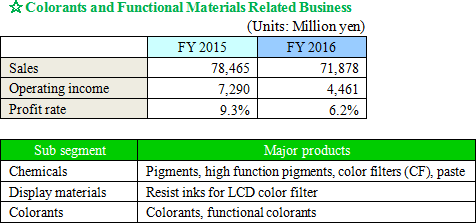 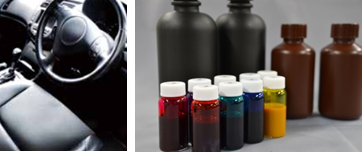 Furthermore, the Company's dispersion processing technologies are used not only for organic pigments but also inorganic materials such as carbon nanotube (CNT), which lead to expansion of their business in the new energy field such as secondary battery materials. They constitute about 40% of the Company's operating income.  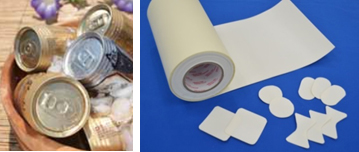 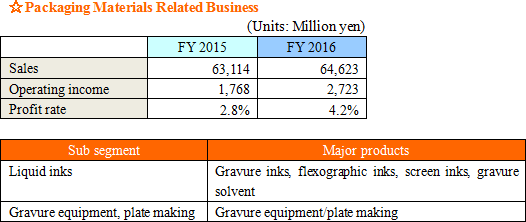 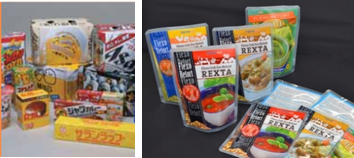  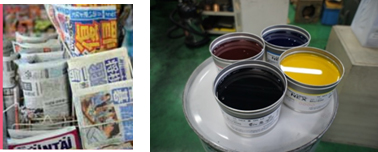 The Company offers not only printing inks but also sales of machinery/equipment, support for streamlining customers' printing process, and support and tools for color management and color universal design. ◎ Overseas expansion
While the Company is improving profitability by offering high-value-added products in the Japanese market, where a rapid growth is not expected, it is aggressively expanding its business from both production and sales perspectives in the overseas market where future growth is expected. Development of its overseas manufacturing structures was almost completed during the previous Midterm Business Plan, and the Company is carrying out both raw material procurement and production at the local sites. As of the end of March 2016, the Company has 50 overseas subsidiaries and 51 plants in 23 countries around the world. 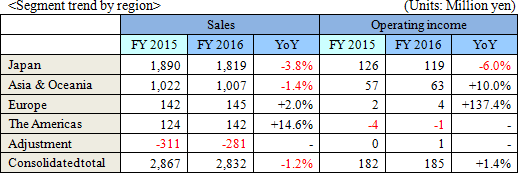 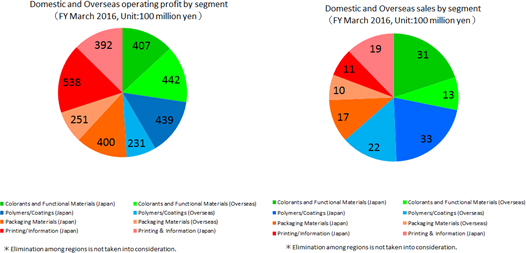  ROE is expected to increase by enhancing margin and efficiency (total asset turnover rate). (1) Strong technological edge (2) Excellent problem solving skills
One of the reasons for the Company to be at the top of the Japanese printing inks industry is its excellent problem solving capability in all aspects of printing. The Company not only produces and supplies printing inks but also studies elements related to "printing" as a whole including plate making and images. Such efforts enable the Company to make technological proposals, demonstrate advanced service skills, and obtain high customer satisfaction. (3) Environmental concerns
The Company is a forerunner in CO2 emission reduction as well as production of eco-friendly inks such as non-VOC inks, water-base inks, and UV inks. In the newly developed countries, too, the environmental regulations are becoming tighter, and the needs for environmentally friendly products are increasing. The Company is also working on assuring safety such as chemical substances control and manufacturing a line of products that meet the Swiss Ordinance, ahead of other companies.
(4) Uniqueness of management strategies
The Company considers M&A as one of the options for exploring new markets with its technological edge, if M&A is expected to bring synergy effects to the Company. It is also taking an initiative in the printing ink industry to establish "local production for local consumption" policy in the overseas market for enhancing efficiency (e.g. reduction in transport mileage) and social contribution (e.g. utilization of local products) purposes.
|
| 1H of Fiscal Year March 2017 Earnings Results |
 Sales growth is slight, but operating income grew due to the improvement in profit rate, etc.
Sales decreased 5.6% YoY to 133.1 billion yen. The sales declined because of the downturn of demand for printing and LCD-related business in Japan, the slowdown of the Chinese economy, and exchange rate fluctuations. Operating income grew 4.8% YoY to 8.8 billion yen. The effect of the decrease of highly functional products, exchange rate fluctuations, and the drop in selling prices was offset by the reduction in raw material cost, fixed cost, etc. and profit rate improved. Ordinary income decreased 10.0% YoY to 7.8 billion yen. For the previous term, an exchange gain of 12 million yen was posted, but for the current term, an exchange loss of 1.2 billion yen was posted. 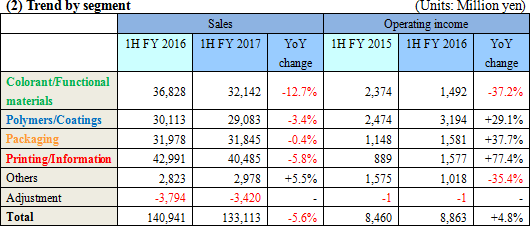 ☆Colorants and Functional Materials Related Business
Sales and profit dropped.
<Chemical products>
The sales of pigments were sluggish in the printing field, but the sales of pigments for painting and coloring plastics grew. As for CF paste, demand weakened and profit decreased.
<Display panel materials>
The domestic business operation in the panel market has recovered. There are signs of recovery in China and Taiwan, but its business performance is still sluggish in South Korea. The company is striving to produce good results for the newly developed resist inks for panels and image sensors as soon as possible.
<Coloring agents>
The performance of automobile-related business has been healthy. Its share in the container-related market increased, and the beverage-related demand was strong and favorable. The company is steadily proceeding with the horizontal expansion of products targeted at global key accounts and the promotion of solar cell-related products, which are being evaluated. ☆Business related to polymers and printing
Sales decreased, but profit grew.
<Packages>
The overseas distribution of adhesives for packages progressed. The performance of paints for cans was healthy, thanks to continued sales promotion. The sales of adhesives for paper, films, and labels declined in the lackluster market. <Electronics and optics>
The new sales promotion of adhesives for ICT progressed. The sales of functional films were promoted in South Korea and China. New products contributed to sales expansion, but the effect of exchange rates got stronger. <Automobiles/industrial purposes>
The sales promotion of adhesives for automobiles and industrial use, including building materials, progressed.
<Healthcare>
In Jul. 2016, the company started operating the business of poultices.
☆Package-related business
Sales decreased slightly, but profit grew.
<Inside Japan>
The domestic package market has been healthy. The shift from rigid containers to pouches is progressing, and the needs for the packaging of individual products are growing. The company will develop gravure inks for highly functional face and reverse printing, and strive to attract new clients in the field of flexographic printing. <Outside Japan>
Toyo Ink SC Holdings proposed solutions of environmentally friendly products (water-based/EB) at "Drupa," the world's largest exposition for printing and cross-media solutions. Water-based products sold well in Asia, as the VOC regulations were enforced and so on. In Asia, including India, the performance of middle-grade products was healthy. The performances of new business establishments in the inland of China, Brazil, etc. are improving. ☆Printing and information-related business
Sales dropped, but profit grew.
<Inside Japan>
The scale of the offset printing market (commerce, publication, and newspaper) is still shrinking. The scale of the entire market dropped 3% in the first half. The rationalization of inkjet ink, offset ink, etc. is progressing, and the sales promotion of UV ink progressed further, as new business establishments were built. As for LCD coating agents, the sales of antistatic HC for OLED-TV targeted at the Korean market grew considerably. The demand for optical HC is growing, as the smartphone market in China is thriving. <Outside Japan>
While the offset printing market is shrinking structurally, the UV ink market is growing due to the needs for package printing and electric power saving. The production outputs at factories in Brazil and India are growing. The production process of UV ink is being transferred around the world. 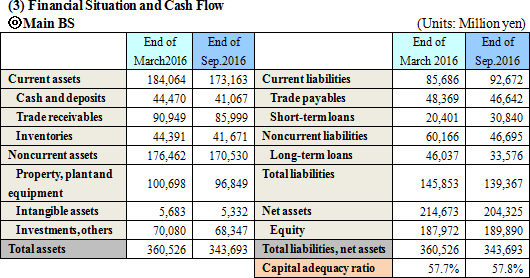 Total liabilities decreased 6.4 billion yen from the end of the previous term to 139.3 billion yen, due to the decline in long-term loans, etc. Net assets declined 10.3 billion yen from the end of the previous term to 204.3 billion yen, as retained earnings grew, but foreign currency translation adjustment dropped through the yen appreciation. As a result, equity ratio rose 0.1 points from 57.7% at the end of the previous term to 57.8%. 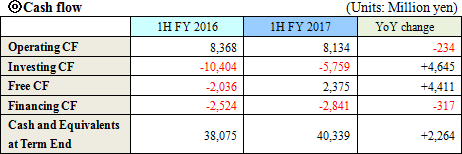 Investing CF recovered, due to the decrease in expenditure through the acquisition of investment securities, etc. As a result, free CF became positive. Financing CF declined due to the increase of treasury shares. The cash position improved. (4) Topics
As a "science company that contributes to the world," Toyo Ink SC Holdings promotes the integrated operation of global business, tries to improve the transparency of business administration by disclosing the information on business administration timely and properly, and decided to end each accounting period in December rather than March, following the global standards, so that the financial results can be compared with competitors' more easily.
◎ The accounting period changed  The term ending Dec. 2017 is recognized as the final period for the mid-term plan "SCC-III," and the term ending Dec. 2018 will become the first period of the next mid-term plan. The next plan is to be announced in Nov. 2017. |
| Fiscal Year March 2017 Earnings Estimate |
 No change to the earnings forecast. Sales and operating income estimated to grow.
The sales for the term ending Mar. 2017 are estimated to grow 2.4% YoY to 290 billion yen. The business environment is forecasted to remain severe, but sales are projected to grow in all business segments. Operating income is estimated to rise 5.6% YoY to 19.5 billion yen. Profit, too, is forecasted to increase in all segments. The dividend is to be 16.00 yen/share, up 0.50 yen/share from the previous term. Payout ratio is forecasted to be 39.5%. 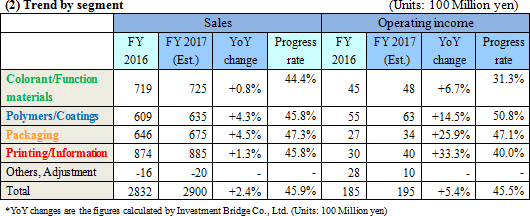 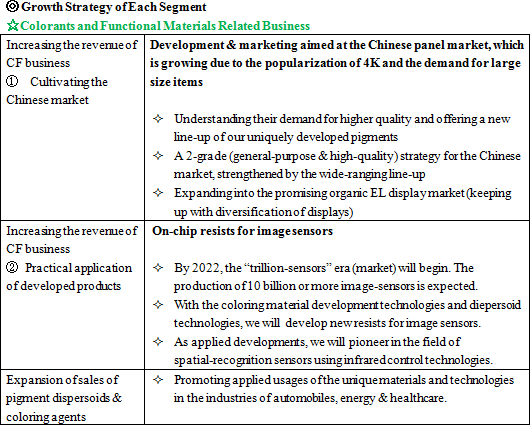 ☆Polymers & Coatings Related Business
With the 3 pillars for growth - "new products/markets: electronics/optics, new energy market and environmental measures", "global expansion" and "new business: expanding into the field of medical science" - the company has set up the following priority targets.
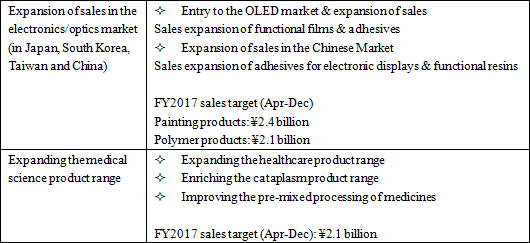 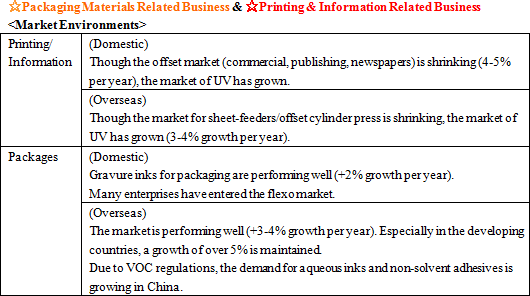   |
| Conclusions |
|
Compared with the results in the past 5 years, the progress of both sales and profit is not massively but slightly slow. It is difficult to predict the trend of exchange rates, but in the short term, we would like to pay attention to how much the company will increase sales and profit in the 3rd and 4th quarters. It became difficult to achieve the numerical goal for "SCC-III," but we look forward to seeing the outcomes of business in the fields of "life science," "communication science," and "sustainability science" for the term ending Dec. 2017.  |
| <Reference : Midterm Business Management Plan, SCC-III> |
|
(1) Midterm Business Management Plan, SCC-III
The Midterm Business Management Plan, called Science Company Change (SCC), began in April 2008. In April 2014, its 3rd term, "SCC-III Evolution Plan" for April 2014 to March 2017 began.
 ◎ Business domains and technology platforms
In the SCC-III, the Company is aiming to "transform from Specialty Chemical Manufacturer to a Science Company" and established 3 business domains and 5 technology platforms. Through collaboration between the "Group Technology Center", which is the laboratory facility of the Holdings, and business departments of each group company in Japan and overseas, the Group will carry out basic research and product development.
<Business Domain>
Each business domain sets priority areas and will continuously develop and offer products that respond to the changing tide and market needs. Although the progress thus far is uneven, development of secondary battery related parts in the "Sustainability Science" domain reportedly started showing good results from this FY.
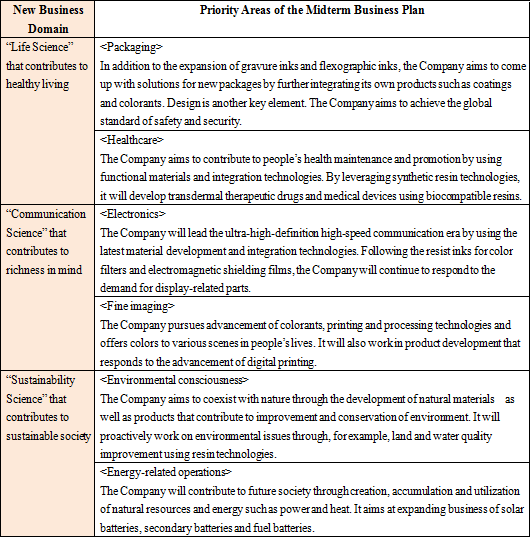 <Expansion of Technology Platform (TPF)>
Technology platform refers to technology accumulation and basic technologies that will be the basis and foundation for developing new products.The Company initially had three conventional TPFs: 1) "Specialty Materials" that advance existing materials to special materials, 2) "Material Processing" that adds functions and values with unique processing technologies to specialty materials, and 3) "Converting Components" that process materials to meet diversifying and advancing needs. Then Company added two more TPFs. One is "Module Designing," which is a technology for examining products from customers' point of view and reflecting the results in the downstream expansion of products and development of new products. The other is "Solution," which is aimed at creating products that are valuable for the users by proposing design and formation. Thus the Company has a total of five TPFs.  ◎ Plans for each business segment
The Company aims to expand its four business segments in a well-balanced manner.The potential growth of "Colorants and Functional Materials Related Business" with a focus on LCD color filter, which occupies about 40% of the current operating income, is high but subject to economic trends. Printing inks, on the other hand, can expect little of their market growth, but they are less likely to be affected by the changing economic environment. The Company will pursue market development in newly emerging countries based on the principle of "local production for local consumption" to obtain stable income base for the "Printing and Information Related Business" and "Packaging Materials Related Business" segments. At the same time, it will pursue growth by developing and selling new high-value-added products for the "Colorants and Functional Materials Related Business" and "Polymers and Coatings Related Business" segments. 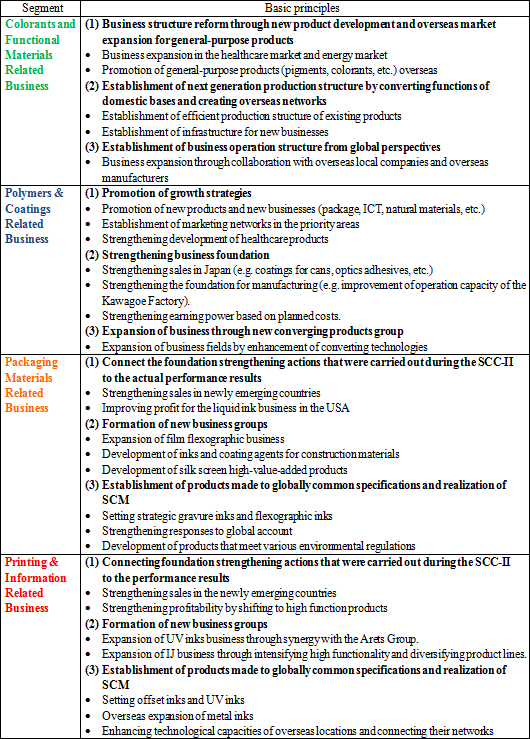 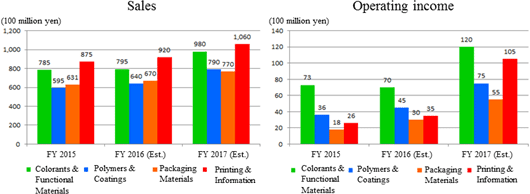 ◎ Overseas expansion
The goal of SCC-III for the overseas sales ratio is 50% (it was 43% during FY 2015).The local manufacturing structure of printing inks in India and Brazil has been almost completed during the previous Medium Term Plan. From this FY on, the Company is planning to accelerate increase in production amount and strengthen production and sales of adhesives in Asia and the United States for diversification. Furthermore, in an effort to explore new markets, the Company will also work on marketing in Mekong Basin area and Mexico and strengthen sales in Turkey for the possible future local production. In the market of emerging counties, the Company will make efforts to expand sales by selling high-spec products just like the ones sold in Japan, as well as lowering costs of the Company's unique middle-spec products that are high quality and eco-friendly. In developed countries, the Company will make efforts to expand sales of UV inks, which is the Company's strength, taking advantage of growing number of Japanese printing machinery sold in Europe and the U.S. The UV inks for packaging made by Arets International NV (current Toyo Aretz International NV), which was acquired by the Company in April 2013, will also be strong weapon for the Company. ◎ Strengthening management foundation
In addition to the above-mentioned actions to expand the business, the Company is making efforts to strengthen management base through "strengthening the manufacturing base" with a focus on cost reduction, "promotion of environmental management" to reduce CO2 emission, "development and utilization of human resources" by expanding diversity, and "streamlining management" by introducing integrated systems on a global scale.
 (2) Message from the Company to the investors
As stated in our management philosophy, we Toyo Ink, a lifestyle creating company, is always aiming to develop products from the consumers' perspective.Even if you have never heard of our name, we would like you to know that our products are used in various situations in your life. Not as a mere ink manufacturer but as a science company, we will continue looking towards the client companies' future and plan to expand the range of products that are essential to the society. We added "improving shareholders' value" last year in its Guiding Principle, and are successfully changing the corporate minds and the mind of employees. We would like our investors to see our steady growth through new product development and overseas expansion, and seek support from our investors from mid- to long-term perspectives. |
| <Reference 2 : Regarding Corporate Governance> |
 ◎Corporate Governance Report
The corporate governance report was updated on Jul. 5, 2016.
  |
|
Disclaimer
This report is intended solely for information purposes, and is not intended as a solicitation to invest in the shares of this company. The information and opinions contained within this report are based on data made publicly available by the Company, and comes from sources that we judge to be reliable. However we cannot guarantee the accuracy or completeness of the data. This report is not a guarantee of the accuracy, completeness or validity of said information and or opinions, nor do we bear any responsibility for the same. All rights pertaining to this report belong to Investment Bridge Co., Ltd., which may change the contents thereof at any time without prior notice. All investment decisions are the responsibility of the individual and should be made only after proper consideration.Copyright(C) 2017 Investment Bridge Co., Ltd. All Rights Reserved. |



